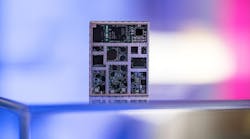After stumbling into regulatory battles across three continents, entering caustic legal battles with Apple over its licensing terms, cancelling its $44 billion deal for NXP Semiconductors, fighting off a hostile takeover bid from Broadcom, and stumbling into the middle of a mounting trade war between the United States and China—Qualcomm is finally done with 2018.
The San Diego, California-based company said that it had revenues of $5.8 billion in the fourth quarter, down from $5.9 billion in the same quarter last year. Qualcomm reported losses of $500 million, down from profits of $200 million over the last year. Annual revenues were $22.7 billion, up from $22.3 billion in 2017. The company’s total losses were $4.9 billion, a nosedive from $2.5 billion of profit last year.
The losses include the $2 billion payment to NXP Semiconductors, a $1.2 billion charge related to fines imposed by the European Commission while Qualcomm appeals the verdict and $687 million in charges as a result of the company’s cost reduction plans. The losses were softened by a $676 million gain related to its settlement with the Taiwan Fair Trade Commission in August.
Profits for Qualcomm’s semiconductor business unit were 796 million in the fourth quarter, down from $973 million in the last fourth quarter. Revenues stayed roughly the same over the last year, at $4.65 billion. The licensing business unit—which accounts for most of the company’s profits— finished the fourth quarter with $739 million in earnings and $1.14 billion revenue, down from $829 and $1.21 billion over the last year, respectively.
The company shipped 232 million chips for connecting electronic devices to cellular networks, an annual increase of around 5 percent despite Qualcomm being replaced with Intel in all the latest iPhones. Apple’s decision resulted in a 55-million-unit shortfall compared with the same quarter last year, according chief financial officer George Davis. “We expect the Apple share reduction to be most impactful in our fiscal first quarter,” he warned last week.
The company is fighting over billions of dollars of breach of contract claims with customers including Apple, which has stopped paying Qualcomm royalties for patents central to 3G and 4G communications. Last month, Qualcomm said that Apple is $7 billion behind in payments, an amount Apple has contested. While Apple has accused the company of unfair licensing practices, Qualcomm has accused it of patent infringement.
Despite everything, Qualcomm closed the year with operating profits of $700 million, down from $2.6 billion since the fourth quarter last year. “We are executing well on strategic objectives, including driving the commercialization of 5G globally in 2019 and returning significant capital to our stockholders,” said Steve Mollenkopf, Qualcomm’s chief executive officer, referring to its $30 billion share repurchase program, in a statement.
The company is projecting first quarter revenue in the range of $4.5 billion to $5.3 billion, he added. “We expect the pace of 5G deployments to meet or exceed that of 4G networks,” he said. “In 5G, we are well-positioned with design wins at all our key Snapdragon customers. The added complexity of 5G is also driving additional RF content per device, including combinations of sub-6-gigahertz and millimeter wave.”
The company is also prying into the market dominance of companies like Qorvo and Broadcom. Sales of wireless components, ranging from power amplifiers and filters to switches and tuners, have increased almost 100 percent over the last year among customers other than Apple. Last month, Qualcomm announced that it had reduced the size of 5G millimeter wave antennas, which could be critical to future smartphones, by 25 percent.
Qualcomm is also trying to move on from the cancelled NXP deal, which would have turned it into the largest supplier of automotive chips by revenue. The Eindhoven, Netherlands-based NXP is trying to answer its own questions, including how to restart growth that seems to slow down every quarter. In an attempt to calm shareholders, NXP is planning to repurchase $5 billion of shares.
While the San Diego, California-based company is depending on the future of wireless networks to staunch the bleeding, NXP is gambling on the future of factories and automobiles to boost business. Their importance was underlined in the third quarter when Eindhoven, Netherlands-based company promoted Kurt Sievers, general manager of its $4 billion automotive business unit, to president.
But the company is grappling with the fallout from the trade deadlock between the United States and China. Third quarter revenues were $2.45 billion, an increase of around 2 percent over the last year. That was even slower than last quarter when the company—the world’s largest supplier of automotive chips— boosted sales to $2.29 billion, according to chief executive officer Richard Clemmer.
Secure connected device sales rose around one percent annually to $717 million as general-purpose microcontroller shipments softened the blow from significantly lower demand for chips used to enable mobile wallets. The automotive business jumped to $990 million. Sales of advanced analog and radar chips more than enough to compensate for slowing shipments of chips used in cars to control everything from windshield wipers to engine control.
“Our OEM customers reduced their pulls based on this fear, uncertainty and doubt about the economic environment,” he said on a conference call with analysts last month. “We think that that's relatively short-lived. There was no issue on the content whatsoever. It was just on actual volume.” Profits came out to $1.26 billion, down slightly from $1.22 billion in the same quarter last year.
